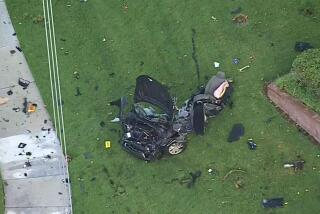Train’s Speed at Issue
- Share via
OMAHA — Dispatchers underestimated the speed of 31 runaway rail cars careering toward downtown Los Angeles on Friday when they decided to switch the cars to a side track, causing the trains to derail and crash into a Commerce neighborhood, Union Pacific officials said Monday.
In their most detailed description of how the derailment occurred, railroad officials said the dispatchers believed the cars, weighing 3,883 tons, were going slowly enough that they could be diverted off the main tracks without derailing.
The dispatchers only discovered two or three minutes before the derailment that the cars were traveling much faster -- 70 mph by some estimates, officials said. By then, dispatchers already had used a remote-control system to change the direction of the tracks and it was too late to change back, Union Pacific spokesman John Bromley said.
“Right before it derailed, there was an assumption that it possibly would have stopped on its own,” Bromley said.
The cars jumped the tracks and slammed into a residential neighborhood, flattening two homes and damaging several others. About a dozen people suffered mostly minor injuries and the neighborhood was littered with thousands of pieces of plywood.
Top officials at Union Pacific headquarters in Omaha continued Monday to piece together what caused the cars to break away from a Montclair rail yard and speed out of control for 30 miles.
Dispatchers, working out of the company’s San Bernardino control center, had 26 minutes to figure out what was going on and what to do. They made the decision to redirect the train because they were worried about rail workers who were working in the train’s path. Another overriding concern was that the cars were nearing Redondo Junction just south of downtown, a crossroads for freight rail lines, Amtrak and Metrolink commuter trains.
Union Pacific has been criticized in the wake of the crash by some railroad union members for not directing the train onto a siding track in Santa Fe Springs, where trains could have derailed in an area away from homes.
Railroad officials dispute this notion, saying that directing the cars into that rail yard could have been even more dangerous. That rail yard contained hazardous materials and fuel containers, they said.
“That would affect far more people and create more problems for the community,” said Kathryn Blackwell, manager of corporate communications for Union Pacific railroads.
Union Pacific’s assertion that dispatchers weren’t certain how fast the trains were going was met with skepticism from some rail workers as well as Commerce city officials.
“They know how fast those trains are going, all the time,” said a Union Pacific engineer, who would only speak on condition of anonymity. “There are sensors all along the tracks, every two miles or so, that go back to dispatch. I don’t believe them at all.”
Added Commerce spokesman Brian Wolfson: “They keep telling us no they didn’t know how fast the train was going, and that’s unacceptable.”
An investigator from the National Transportation Safety Board has said that rail workers had intentionally disengaged the train’s main braking system without setting backup hand brakes or putting wood blocks behind the wheels to stop the line of cars from moving.
The investigator, Dave Watson, said such actions are sometimes taken so workers can maneuver cars around rail yards. But in this case, with nothing to stop them, the rail cars slid backward, rumbling out of the yard and downhill toward Los Angeles.
*
Mathews reported from Omaha and Streeter from Los Angeles. Times staff writers Li Fellers and Allison Hoffman contributed to this report.
More to Read
Sign up for Essential California
The most important California stories and recommendations in your inbox every morning.
You may occasionally receive promotional content from the Los Angeles Times.










